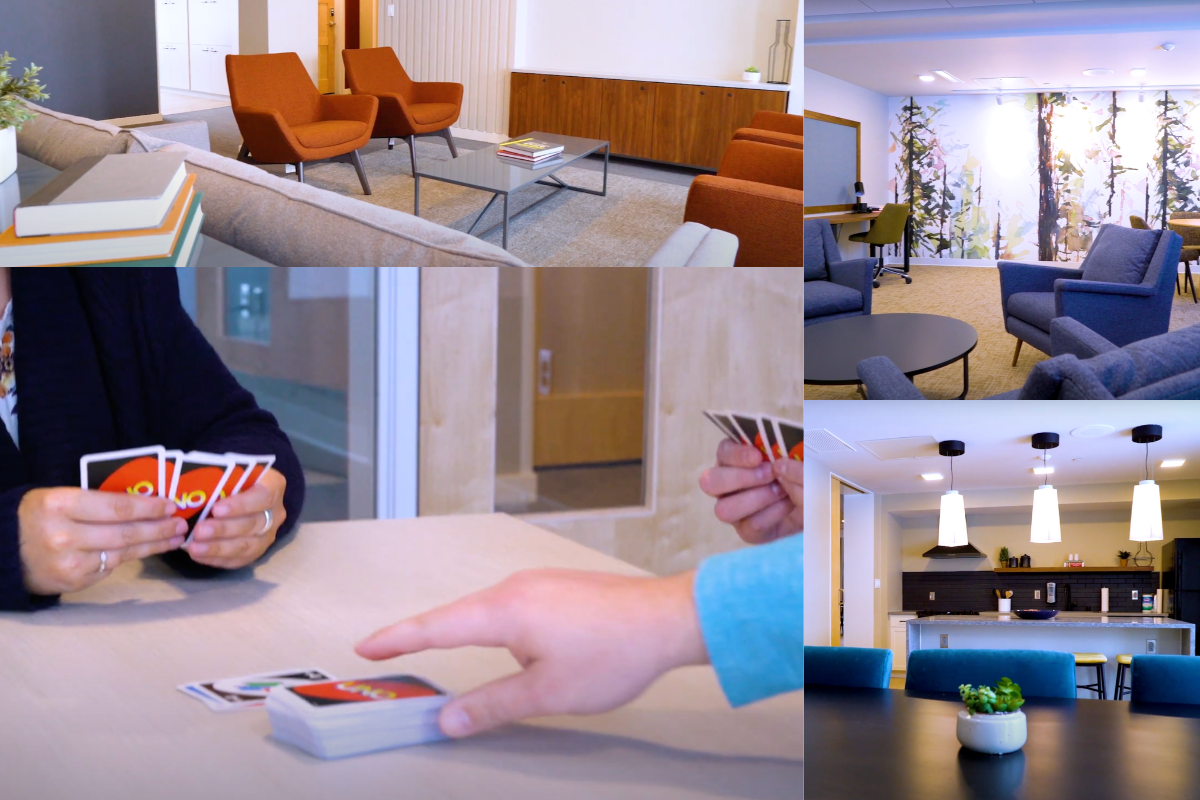Recently, we published a blog, What is IRTS, anyway?, highlighting the importance of Intensive Residential Treatment Services (IRTS) in our communities. In that piece, we talked to staff about what their roles and days look like working with clients in IRTS. Now, we’re sharing more about IRTS programming from a client’s perspective.
Programming in IRTS includes group education, medication management, opportunities to interact with staff in therapeutic relationships, and real-life skill building to help clients transition back to independent living.
Daily Schedule
Here’s what a weekday looks like for a client in our IRTS program.
8:30-9:00 a.m. Wake-up calls and medication monitoring
9:00-9:30 a.m. Breakfast and medication monitoring
9:30-10:00 a.m. Treatment Goals and Symptom Management Group
10:00-10:30 a.m. Free time
10:30-11:30 a.m. Illness Management & Recovery and Dual Disorder Treatment groups
11:30 a.m.-1:00 p.m. Lunch and free time
1:00-2:30 p.m. Healthy Living Skills and Therapeutic Recreation groups
2:30-5:00 p.m. Free time and medication monitoring
5:00-6:00 p.m. Dinner and clean up
6:00-6:30 p.m. Healthy Living Skills and Therapeutic Recreation groups
7:00-11:00 p.m. Free time, medication monitoring
11:00 p.m. Curfew
Groups
Within the groups below, staff customizes topics—rotating in weekly themes—to meet the needs of current residents. Topic examples include physical health, relationships, financial management, education, and employment. Each week looks different, and is thoughtfully designed by staff with participants’ input to maximize the program’s therapeutic benefit.
Here are a few examples of groups offered:
The Illness Management and Recovery Program consists of weekly group sessions to help people who have experienced psychiatric symptoms develop personalized strategies for managing their mental illness and moving forward. This group helps people make sense of their mental illness by focusing on practical information about diagnoses. The curriculum offers a variety of information, strategies, and skills that clients can use to further their own recovery.
Co-Occurring Disorders Treatment refers to treatment modules for people with a mental illness and a co-occurring substance use disorder. Integrated treatment can stabilize symptoms of co-occurring disorders and provide the foundation for lasting recovery. The program consists of group sessions providing education about substance use and psychiatric disorders, their interaction, common problems, causes, and options.
Therapeutic Recreation is a treatment service designed to restore, remediate and rehabilitate a person’s level of functioning and independence in life activities, promote health and wellness, and reduce or eliminate limitations to participation in life situations caused by an illness or disabling conditions. This means using recreation and leisure activities to promote independence and quality of life while increasing self-esteem and decreasing limitations. It’s also a way for residents to have fun, socialize, try new activities, and learn more about the importance of having structured leisure time after discharge.
Add therapeutic and educational opportunities like yoga, apartment rental information, job-seeking skills, household management skills, preparing nutritional and affordable meals, and budgeting a fixed income to these groups—and you’ll get a picture of just how powerful IRTS programming can be.
The Value of IRTS
People often come to IRTS as a step down from hospitalization. It helps them transition from a completely locked and restricted environment back into the community by continuing 24/7 professional mental health support, allowing more freedom and expecting more self-responsibility.
Sometimes people come to IRTS as an alternative to hospitalization when in crisis but do not meet the criteria for hospital admittance. That was the case with one client who shared, “I feel it’s so important we have alternative spaces like this for folks who don’t require such an intensive inpatient or involuntary care but still need and deserve a safe space to heal and recover.”
This same client also shared, “I arrived to welcoming staff whose warm and friendly demeanor made me immediately feel comfortable. I was told exactly what my stay would look like… I also appreciated I was still able to have the opportunities to have outings with my family, as family is a huge support for me, and that helped my healing. This is not a common accommodation while in a hospital setting.”
This individual’s time in IRTS was healing for her, as it has been for many people we serve. We’re proud to offer this program, which allows people who need time, space, and support to heal close to their families and communities while building skills and helping them experience a supported, growing independence.

